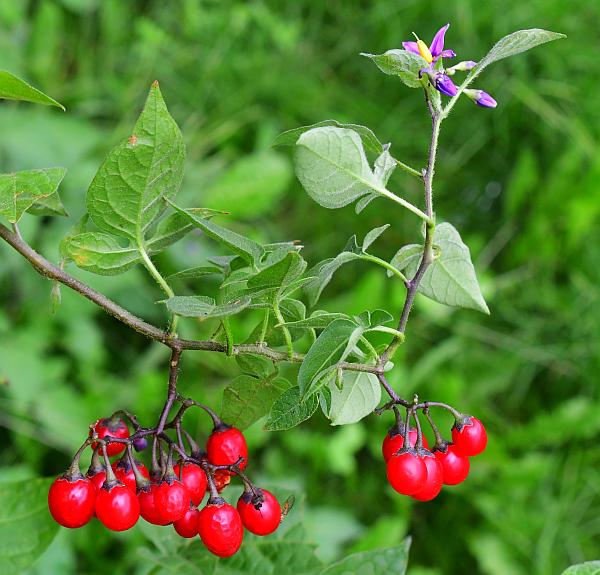Solanum dulcamara L.
Climbing Nightshade

Introduced
CC = *
CW = 0
MOC = 7
© SRTurner
Solanum dulcamara L.Climbing Nightshade | |
 |
Introduced CC = * CW = 0 MOC = 7 |
© SRTurner |
|
Family - Solanaceae Habit - Rhizomatous perennial forb, liana-like. Stems - Twining and climbing in other vegetation, often woody at the base, to 3 m, glabrous or sparsely pubescent, unarmed.
Leaves - Alternate, petiolate, entire. Petioles often narrowly winged. Blades 2-6 cm long, simple, ovate to broadly ovate, more or less heart-shaped, or halberd-shaped, tapered to a sharply pointed tip, truncate to cordate at the base, those of at least some of the leaves with 1 or 2 shallow to deep, spreading to somewhat downward-angled lobes at the base, the lobes much smaller than the central blade, the surfaces glabrous or sparsely pubescent along the main veins with short, curved to appressed, 1- or few-celled, nonglandular hairs, some of these sometimes branched.
Inflorescence - Axillary and terminal cymes or panicles, loose, to 8 cm long, arising opposite the leaf at node. Branches of inflorescence purple, antrorsely pubescent. Pedicels to 7 mm long, purple.
Flowers - Calyces 2.0-2.5 mm long, 5-lobed to above the midpoint, the lobes broadly triangular, the outer surface sparsely short-hairy, the hairs nonglandular. Corollas 4-5 lobed, 6-9 mm long, purple with a pair of yellow or green spots at the base of each lobe, the lobes lanceolate, recurved at full flowering, the inner surface glabrous, the outer surface minutely nonglandular-hairy toward the tip. Anthers 5, 3.5-4.5 mm long, oblong, yellow, lacking a sterile tip, dehiscing by terminal pores. Ovary 2-locular, ovoid, the surface glabrous, the style exserted from the anther ring, glabrous, 7 mm long.
Fruits - Berries 0.8-1.1 cm long, broadly ellipsoid to elliptic-ovoid, lacking granules, the surface glabrous, red, shiny, lacking white flecks. Seeds 2.5-3.0 mm long, broadly ovate to nearly circular in outline, often minutely notched at the attachment point, strongly flattened, unwinged, the surface with a minute network of ridges, often appearing pebbled, orangish brown to brown.
Flowering - May - November. Habitat - Bottomland forests, streambanks, roadsides, fence rows, farmyards. Origin - Native to Eurasia. Lookalikes - None. Other info. - This plant is uncommon in Missouri, so far known from only seven counties. It is far more common in more northern latitudes. prevalent in both the northeastern and northwestern U.S., and ranging into Canada. The plant is easily recognized by its vining habit, purple flowers with yellow stamens, and clusters of fruits which turn from green to red as they ripen. The main leaves typically have basal lobes, as in the images above, though smaller leaves often lack these. The plant is visually attractive but considered a noxious weed in some northern climes. All parts of the plant are poisonous, with the toxins including steroidal alkaloids and glycosides. Photographs taken at Lake Geneva State Park, Geneva, OH. 8-4-00, and in Marquette, MI., 9-10-03 (DETenaglia); also in Spokane, Spokane County, WA, 6-12-2015, at the Al Sabo preserve, Kalamazoo County, MI, 7-2-2016, and in Fremont, Newaygo County, MI, 8-28-2020 (SRTurner). |